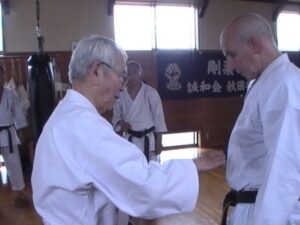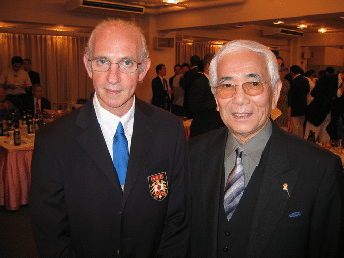Leo Lipinski interviews Tasaki Shūji – Gōjūryū Karatedō Legends
| We originally published this interview to www.gojuryu.net in 2002 however Leo Lipinski Shihan had conducted the interview some years before in 1987. We would like to disseminate the original publication now as there seems to have been many modifications via re-syndication over the years thus watering down the original content and context of those mentioned. |
LEO LIPINSKI: When where were you born?
- TASAKI SHŪJI 田崎修司: I was born 1933 January 20 in Tokyo.
I began training in Gōjūryū Karatedō 1951 August 15 and I am now the Vice Chief Director of Japan Karatedō Federation Gōjūkai 全日本空手道連盟剛柔会 and an official and national instructor for the Japan Karate Federation 全日本空手道連盟.
LEO LIPINSKI: What was Available when you started training?
- TASAKI SHŪJI 田崎修司: There was boxing, and other forms of Karatedō, but schools where not rigidly organized. There were no particular ryūha names.
LEO LIPINSKI: Why did you choose karate?
- TASAKI SHŪJI 田崎修司: There were many foreigners in Tokyo. I chose karate for self-defense and the strong fighting. There were many street fights then and I wanted the ability to fight back.
LEO LIPINSKI: Which Ryu did you begin with and why?
- TASAKI SHŪJI 田崎修司: Yamaguchi Gōgen 山口剛玄 sensei was my first teacher, and the only teacher for me. Yamaguchi Gōgen recognizes me as one of his few remaining students. I chose this style out of the chance because the former Gōjūkai Honbu dojo was located in Asakusa and Yamaguchi Gōgen was living there. At the time, Yamaguchi Gōgen Sensei had only had 6 – 8 students and back then Yamaguchi Gōgen personally taught classes. I remember Nakaishi sensei that was directly under Yamaguchi Gōgen. I do not know where that sensei is now. There were two other senior instructors – Mayama Motomasa 間山統正 Sensei and Onishi Kenichiro Sensei.
LEO LIPINSKI: What was training like in those days?
- TASAKI SHŪJI 田崎修司: Compared with now – it is heaven. In those days it was hell. Lessons are now more scientific. The first 8 – 10 months were of building the basics intensively and physical strength to be able to use the techniques as a good foundation. No karate techniques were taught in the first 10 months.
LEO LIPINSKI: What kind of basic training?

Shuji Tasaki and Leo Lipinski
- TASAKI SHŪJI 田崎修司: Jumping, sit up’s etc. To the limit of endurance. Many fell. No fun and very few continued. Very few now take that kind of training.
LEO LIPINSKI: What do you remember as a highlight?
- TASAKI SHŪJI 田崎修司: Yamaguchi Gōgen 山口剛玄 Sensei did everything with the students – even then. If I did this today, there would be no students. Learn how to breathe – A fundamental karate technique. That is why at my age, I can be more than equal to the younger instructors.
LEO LIPINSKI: You won the first Gōjūkai tournament. What are your views of tournaments then and now, and how do you feel about the change?
- TASAKI SHŪJI 田崎修司: First Gōjūkai tournament held for the combined years of 1963 and 1964 and I won the finals representing Tokyo. The 2nd tournament was in Wakayama and I took 2nd place. That 2nd year, Hirano Osamu 平野脩 of Wakayama won, he was three years younger than I.
In the same year (1965) at the second tournament, the Federation of All Japan Karatedō Organizations 全日本連盟空手道組織 (FAJKO would later become the Japan Karatedō Federation) was born, asking not to have further tournaments until 13 years later. The kumite was different in the beginning with no point system. Back then the dojo style kumite and all the presently forbidden techniques were permissible. When the Federation of All Japan Karatedō Organizations 全日本連盟空手道組織 was formed in 1965, instead of dojo kumite, point kumite was developed.
Gōjūryū, Wadōryū, Shitoryū and Shotokanryū made the federation. I have had a preference for teaching the dojo kumite versus the point style. I teach as I was taught.
As long as one has one has mastered the Gōjūryū kumite, the other can be adjusted. If trained in Gōjūryū dojo kumite, you can continue after reaching middle age. Point fighting would not result in this. If you lose your speed, you lose your karate.
By application, Gōjū dojo kumite gives you the edge, as it is not dependent on your youth. In karate if you step back, you lose everything. Side stepping is good, younger have speed, older are slower. Therefore, you must step in to receive. If you train only in modern karate, once you are past 30 years your karate is over.
LEO LIPINSKI: What place do you see Karate having in the modern world?
- TASAKI SHŪJI 田崎修司: First, spiritual and mental strength. The real value for me today, without this, in this world of trifling things and conflicting values, it is hard to survive. It takes endurance to deal with a definitive purpose and target.
LEO LIPINSKI: Have you ever since starting, had to defend yourself?
- TASAKI SHŪJI 田崎修司: Countless times. These events were in my 30’s and 40’s – In these years people tend to stay away – sensing the need to do so, they stay away from me instinctively.
LEO LIPINSKI: Who were your greatest rivals in kumite?
- TASAKI SHŪJI 田崎修司: Even in kumite, the rivals were many of my seniors, because of the mental and spiritual pressure they give out. Mayama Motomasa 間山統正 Sensei specifically.
(This is possible out of respect for their senior/ Senpei status. There has been no one among his contemporaries and juniors that he considers a particular rival.)
Nishi Sensei and Wakayama Sensei could have this position. They had very strong reputations. They did not attend either tournament in the early days, so we never found out how good they were. Even today, all three are still practicing in their own dojo’s. Not real rivals.
(Tasaki Shūji Shihan wanted to emulate those from 20 years ago.)
- In Kansai area, they still produce very good students. The gap has not been filled. The gap referred to is that Gōjūryū started near Kyoto first and has produced more and better students then the Tokyo area.
LEO LIPINSKI: What are your favorite techniques?
- TASAKI SHŪJI 田崎修司: Kicking, Haitō and Ura uchi
LEO LIPINSKI: What do you consider important in your teaching?
- TASAKI SHŪJI 田崎修司: My attachment to my student. He notices the difference and tries to think of ways to improve each individual student. He also respects the individuality and characteristics of each person and tries to build them up mentally and physically.
LEO LIPINSKI: Each generation seems to have their own great karateka. In your generation, it was yourself and Yamamoto Gonnohyoue 山本権之兵衛. Before and after, who were the special ones.
- TASAKI SHŪJI 田崎修司: Ishihara Katsuichi 石原勝一 Sensei and Chiba Sensei– were two of Yamaguchi Gōgen primary students at the time. Sakamoto Shuji Sensei is another and Takahashi Sensei is the third. Ishihara Sensei was also exceptionally strong. There were 5- 6 others, but they no longer train.
LEO LIPINSKI: What is the meaning of Ōssu?
- TASAKI SHŪJI 田崎修司: Ōssu relates to an Important Japanese value, to endure and press yourself. Ōssu should not be used frivolously. I have often asked karate players if they know what they are saying. It is an abbreviation of “Oshi Shinobu” (押し忍ぶ).
LEO LIPINSKI: With regards to Gōjūkai as opposed to traditional Gōjūryū, can you tell us about your Ryū and how it differs?
- TASAKI SHŪJI 田崎修司: Fundamentally, there is very little difference. If there is, it is the mannerisms of individual students acquired from their Sensei. There are unnecessary superficial differences. In older times Okinawa Gōjū had no kumite. Kumite was developed in Japan. Only recently started kumite in Okinawa. They also now do tournament kumite. Gōjū dojo kumite has a strong reputation for its effectiveness, especially in the days of the old school. Developments, contributions and preservation of Goju dojo kumite has been, by all instructors. What has been preserved is the central idea of what it was in the early days, central to all styles.
Miyagi Chojun Sensei originated Gōjūryū, and the kumite is very close to the kata. Techniques should be applicable in kumite. We must remember the difference between mere kata forms and the actual use of techniques in combat and kumite.
LEO LIPINSKI: What is the Japanese Federation Gōjūkai and the JKF?
- TASAKI SHŪJI 田崎修司: Gōjūkai was re-formed in 1965 and joined the Federation of All Japan Karatedō Organizations 全日本連盟空手道組織 (FAJKO) in the same year. The Gōjūkai was originally formed by Yamaguchi Gōgen 山口剛玄 sensei in 1950. After a few years (Federation of All Japan Karatedō Organizations 全日本連盟空手道組織 (FAJKO)) Yamaguchi Gōgen quit – and the Gōjūkai continued as Nihon Karatedō Renmei Gōjūkai (JKF Gōjūkai 全日本空手道連盟剛柔会). Ujita Shōzō 宇治田省三 Sensei was the president. JKF is the official karate body in Japan and Okinawa.
LEO LIPINSKI: What special incidents do you remember?
- TASAKI SHŪJI 田崎修司: Asakusa dojo – in the years after the war, were violent years. When a student was promoted to black belt, he was to go into the street; bow to the first person then hit him. If he went backwards, it was no good. If he collapsed this was good. This of course cannot be applied today.
LEO LIPINSKI: To finalize the interview, what relationship if any is there between SEIWA KAI and the late Yamaguchi Gōgen’s IKGA group?
- TASAKI SHŪJI 田崎修司: None at all. As I told you, Yamaguchi Gōgen 山口剛玄 sensei was always my only teacher. I was a senior (Senpei) to Goshi his son. We still remain on friendly terms. Our organizations are totally different.

